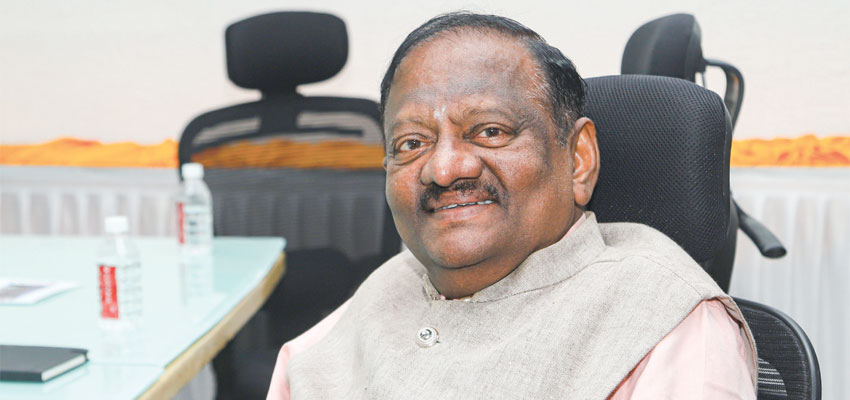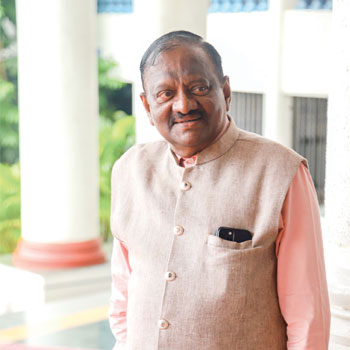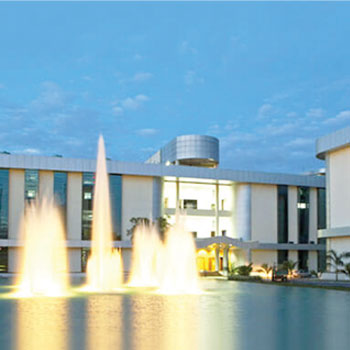The Export-Import Expert

P. C. Nambiar, Director-Group EXIM, Serum Institute of India (SII), who started from scratch without much formal education, is a top-shot corporate leader, who excels in the area of export-import. No wonder he has made a mark in leading companies like Thermax and then Serum Institute of India. He speaks to Corporate Citizen on an array of topics with a nice flavour of personal opinions
Corporate Citizen: Could you tell us a bit about your childhood and early days of your career?
P. C. Nambiar: I come from a small village in Kannur district, Kerala. After matriculation, when I was just over 18 years, I moved to Mumbai, where I started working for a transport company in 1996, ran by D.M. Daruwalla who had previously served as the General Manager of Kodak, USA. I began my career in Mumbai, as a billing clerk and typist, primarily handling warehouse management tasks. Later, I joined a private company, which was venturing into the manufacturing of lithographic, photographic, and reprographic products. Although they had not yet begun production, I was initially brought on to manage their commercial department.
Within a week, they saw potential in my marketing abilities and shifted me to handle both marketing and commercial roles. I became the first person in the company to create a catalogue for our upcoming products. Using pencil sketches and descriptions of each product’s function, I crafted a catalogue that I then used to promote the products in the Mumbai market. I managed to make the first sale, and over two years, I had achieved around three crore rupees in sales for the company.
CC: Could you tell us about your interest in import-export?
I saw an opportunity in import of lithographic films, or “litho films”, which were popular for advertising film posters and other promotional materials. I initiated the import cell, sourcing and distributing litho films for Mr. Daruwalla. Although, we didn’t engage in exports, my interest in expanding into export-import activities continued to grow.
CC: You thereafter worked for Thermax…
Yes. This interest eventually led me to a connection at Thermax, where they were looking for someone to manage import-export operations in Mumbai. I joined Thermax, but after about three months, I realised that the core of the operations needed to be based in Pune rather than Mumbai. In my appraisal, I recommended relocating my position to the factory in Pune, with occasional travel to Mumbai, as needed. This suggestion was accepted, and that’s how I moved to a more operational role at Thermax.
When I came to Thermax, I was able to learn the tricks of the trade and we started the import-export cell. I was its Executive Secretary, directly reporting to then Chairman and Managing Director, Mr. R.D. Aga. That is how Export-Import (EXIM) started in 1987.
CC: When did you begin your innings in Serum Institute of India?
I was approached by the Poonawallas with an invitation to join their team, as they were familiar with my work. I accepted and joined the Poonawalla Group, on 1 January, 1990, taking on the role of group head for import-export.
In this position, I expanded our operations by developing Export Oriented Units (EOUs) and Special Economic Zones (SEZs). I took on roles as both, a developer and co-developer in these projects. Currently, my responsibilities go beyond import-export—I am also involved in the strategic planning and ongoing development of SEZs and EOUs.
"The pace of life has accelerated to such a degree that people are losing a sense of stability and the satisfaction that comes from good deeds and helping others"
- P. C. Nambiar
CC: Tell us about the biopharma SEZ which you established?

I built the country’s first biopharma SEZ in 2005-2006. However, looking at it now, I question whether this SEZ model can truly sustain in India. The objectives we had at the time have shifted, largely due to evolving needs and demands from industries, especially the IT sector.
When we initially drafted the SEZ rules, the economic landscape and our goals were quite different. The idea was to create zones where IT companies could cluster, with infrastructure provided by developers. Smaller IT firms could rent space, set up units, and operate within these buildings. Developers would earn revenue through service charges, leases and user fees.
However, the Covid-19 pandemic introduced a major shift. With restrictions on travel and gathering, remote work became the norm. Corporates soon realised it was more economical to support employees working from home than to invest in large office spaces with amenities like transportation and recreation. This experience reshaped their view on SEZs—they still needed SEZs but now required hardware support for remote work rather than clustered workspaces.
Allowing work from home has reduced the need for shared IT infrastructure, making the original vision of IT/ITES SEZs largely irrelevant. Today, nearly 60-70 per cent of IT operations are shifting outside SEZs, leaving developers with empty spaces and forcing them to lease to other sectors.
As a result, SEZs focused on the service sector are unlikely to remain viable, and a new policy framework is needed to address this shift.
CC: What’s your perspective on the state of industries today?
In the 1980s, starting a small business required navigating a complex web of 27 permissions from different administrative departments—a process that was unpredictable and time-consuming. Now, with reforms to India’s industrial and regulatory framework, it’s possible to establish a small-scale industry within 24 hours. These changes have vastly improved the ease of doing business, saving both time and money and making operations more economical.
One important aspect is, what the government can do to support industries. People often look to the government for subsidies, concessions and benefits, to reduce production and service costs. However, as part of the World Trade Organisation (WTO), we are bound by certain agreements, which, based on economic growth and per capita income, limit our ability to provide subsidies and direct concessions. Consequently, the government has phased out many cash compensations, licensing requirements and direct funding. Instead, businesses now have the opportunity to generate revenue through market-driven solutions, such as transferable licenses, which eliminate the need for outdated support structures.
"During the Covid-19 pandemic, SII played a crucial role in developing and manufacturing the Covishield vaccine. While Oxford University provided the initial seed virus, SII independently developed the formulation and manufacturing process"
CC: What are your observations about youngsters today?

I notice a significant shift in the work attitudes of youngsters. In the past, employment wasn’t merely about earning an income; it was a means to improve one’s quality of life, support family, and foster a sense of belonging in society.
However, with each generation, particularly today’s youth, many have grown up with abundant resources and conveniences, often taking for granted the value of time, money and effort. They have everything readily available, almost like a “two-minute Maggi”, which means they don’t fully appreciate the effort behind these comforts. This has led to a self-centred focus of the parents, where personal material gains seem to overshadow emotional and spiritual growth.
They want the answer of “What’s in it for me?” rather than a desire to help or give back. The pace of life has accelerated, so people are losing a sense of stability and the satisfaction that comes from good deeds and helping others. This can lead to a self-centred approach, where any obstacle in their path is simply something to push aside.
CC: So how will this change come through the parental medium or education?
In my view, part of the problem with sharing our philosophy with the younger generation is how we communicate it. Often, we try to explain concepts in traditional language that doesn’t resonate with them. When we use ancient or conventional explanations without connecting them to modern understanding, they can come across as irrelevant, for young people.
Take, for example, the greeting Namaste—if my daughter asks why we say Namaste, and I simply respond, “It’s a tradition; you should say it to elders”, that explanation doesn’t provide her with a meaningful answer. But, if I explain that our bodies carry energy—protons, electrons and neutrons—and when we bring our hands together, it creates a balance between these energies, she might understand better. Namah means “I salute” and te means “you.” So, saying Namaste is not just a greeting; it acknowledges that the life energy within me salutes the life energy within you. This aligns with the philosophy of “Aham Brahmasmi” meaning that we are all made of the same universal energy. This explanation makes the greeting relevant and insightful.
Similarly, when elders are present, we traditionally touch their feet as a mark of respect. But today, some might only touch the knee, without understanding the reason. If we explain that touching the feet of an elder isn’t just a custom but an exchange of energy, it becomes meaningful. The elder, having accumulated life experience, is thought to carry positive energy. By touching their feet, we symbolically allow our negative energy to be absorbed and replaced by their positive blessings. The elder places their right hand (associated with positive energy) over us, while the left hand (associated with grounding or water) is down, completing the energy transfer.
CC: Tell us about Serum Institute of India (SII).
Serum Institute of India (SII) is a pioneer in global vaccine manufacturing. It is the world’s largest vaccine manufacturer. This legacy is built on a commitment to affordability and innovation.

A prime example is the development of the BCG vaccine for tuberculosis. When SII entered the market, competitors were charging a hefty Rs. 595 per dose. Dr. Cyrus Poonawalla, the visionary leader of SII, challenged the team to develop a vaccine that could be sold at a mere Rs. 55 per dose. This bold decision made the vaccine accessible to millions.
Similarly, during the Covid-19 pandemic, SII played a crucial role in developing and manufacturing the Covishield vaccine. While Oxford University provided the initial seed virus, SII independently developed the formulation and manufacturing process. This indigenous innovation, coupled with SII’s vast manufacturing capabilities, enabled rapid production and distribution of the vaccine.
It’s important to note that Covishield, produced by SII, is distinct from the AstraZeneca vaccine. SII conducted its own clinical trials, demonstrating an efficacy rate of 86%, significantly higher than AstraZeneca’s 54%. This shows SII’s ability to tailor vaccines to specific populations and achieve superior results.
Thus, SII has consistently demonstrated its dedication to public health and its role as a global leader in vaccine manufacturing.
"I built the country’s first biopharma SEZ in 2005-2006 ... When we initially drafted the SEZ rules, the economic landscape and our goals were quite different. The idea was to create zones where IT companies could cluster, with infrastructure provided by developers"
CC: How many generations of employees are you dealing with at SII?
Most of those joining at the junior-most levels today are likely third-generation employees—often the grandchildren of those who started with SII, when it was founded in 1966.
CC: How is the office environment at Serum Institute of India?
Excellent—there has never been a single day of labour unrest. We’ve never faced any labour issues and have maintained a harmonious environment without the need for an external union; we operate with an internal union, which has kept relations smooth and productive.
CC: You’ve worked with a Parsi management for many years. What stands out about them?
They are incredibly kind-hearted, highly professional and trusting. They empower you to make decisions and foster an entrepreneurial approach. Their management style is focused on the big picture, leaving the responsibility for day-to-day decisions and actions to us. This means, I am accountable for every penny spent and for the outcomes of my decisions.
CC: What is the philosophy of life that you live by?
According to me, I am temporarily here. The body is not me, it is a medium for me to express. Therefore, I am not concerned about the failure or success of a reaction. I believe that result of an action is embodied in reaction itself.